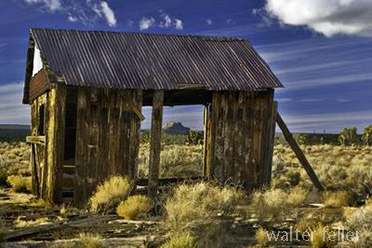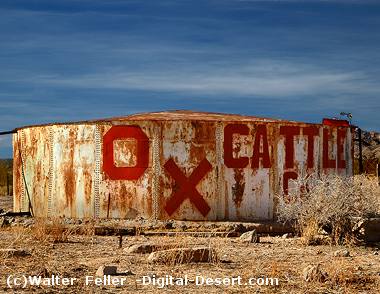Homesteading History in the Mojave Preserve
Much of the land in private hands throughout the West was originally owned by the federal government, and was distributed to private owners through one of several mechanisms designed to promote
the development of an American yeomanry. The most famous of federal land laws was the Homestead Act, which gave homesteaders the right to stake a claim to a portion of the federal domain that could
be theirs for several years of hard work plus a small filing fee. Though the Mojave desert was not nearly as suitable for homesteading as more temperate locations, a series of wet years beginning after
the turn of the twentieth century convinced hundreds of homesteader families to move to the area. Though more than half of all homesteaders failed to gain title to the lands they claimed, many others
met at least a degree of short-term success. When the Mojave National Preserve was created in late 1994, more than 85,000 acres (exclusive of the Catellus railroad grant lands) within the Preserve
remained in private hands. Most of that, some 70,000 acres, was in Lanfair Valley, largely a relic of less than two decades of homesteading activity. [47]
Most of the eastern Mojave was opened to homesteading in 1910. That year, inspired by the gospel of dryfarming techniques, and sensitive to the potential increase in value of property with good access
to transportation, Ernest Lanfair, a merchant from Searchlight, claimed a portion of the valley that would later bear his name. His homestead and several others became the heart of a community along
the railroad, also named for him. Migration to the area rose sharply in 1912 as word spread of Lanfair's bumper crops and free land. Settlers, referred to derisively by cattlemen as "nesters,"
established a post office, a general store, and a school. Farther north, a settlement at Ledge had similar amenities. A 1914 Fourth of July community barbecue, hosted by Lanfair, counted some 400
participants. Future residents would rent a boxcar from the Santa Fe Railway, known as an "immigrant car," load all of their possessions, and then meet the car several days later on a siding in Lanfair
Valley. Newly arrived migrants staked and recorded their claims, and worked to clear and plant a portion of the land to meet government requirements. Later homesteaders often bought the improvements
and claims of former residents who moved before receiving title to the land. That way, the process of gaining title would begin anew, but at least the new arrivals did not have to worry about construction
of a place to live. [48]
Nearby, a group of African-Americans attempted to start a homesteading colony for blacks, called Dunbar. Success would "bring freedom to the colored race," in the words of one local newspaper. An attempt
to establish an orphanage for black children met with only limited success, and closed within a year. Dunbar had its own post office, but as it was located only 200 yards from the Lanfair facility, the two were merged in 1914. Black homesteaders were not only concentrated at Dunbar, but were scattered throughout the area. One historian emphasized that "black families were among the most persistent and successful of Lanfair Valley homesteaders," citing as proof the seventeen families that carried the process through to receive a patent on their land. Former residents of the area remember a state of racial harmony, with integrated schools, but white settlers excluded blacks from many social functions. In Lanfair Valley, blacks and whites could plow together, but they could not play together. [49]
The homesteaders experienced constant conflict with the Rock Springs Land & Cattle Company. The company considered Lanfair Valley to be some of the best part of its range, and resented the "intrusion" of settlement. The company denied water to the settlers, forcing them to use the few public springs or dig expensive wells. Cattle trampled carefully nurtured crops, sometimes allegedly after the cowboys cut the nesters' fences. In return, the farmers would occasionally help themselves to beef. The cattle company brought in hired thugs, and rumors swirled claiming some homesteaders' cabins burned to ashes under mysterious circumstances.
The Rock Springs Land & Cattle Company was a formidable opponent, but the arid environment proved the undoing of the homesteaders. The rush began during years of unusually heavy rainfall, enabling the success of the experiment. Even during the wet years, farming in Lanfair Valley was a dicey economic proposition, and many homesteading families supplemented their farming incomes with wage work in local mines, in Needles or other railroad communities, and on local ranches. Conditions soon worsened, and the homesteaders found that there simply was not enough moisture to grow crops without irrigation. This fact, combined with the crash in agricultural prices after the resolution of World War I, caused many of the homesteaders to leave. When the Santa Fe abandoned its railroad line through the area in 1923, many left, but others waited a little longer, to achieve ownership of their land so that they could sell it and have something to show for their work. The Rock Springs Company and the OX Cattle outfit purchased many of these homesteads. A few homesteaders stayed into the 1930s, but the farming experiment in the Mojave was essentially over. [50]
The homesteading experience failed largely because of environmental and economic factors, but it left a legacy of land in private ownership inside park boundaries. Additionally, evidence of the activities of the homesteaders can still be seen. Required by law to clear and plant a certain portion of their land, the erstwhile farmers pulled up Joshua trees and creosote and turned over the earth. The large vegetation has not grown back, and the square, open fields are conspicuous in the midst of the dense Lanfair Valley Joshua tree forest.
Source - NPS

